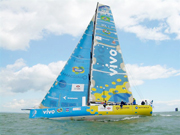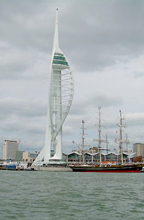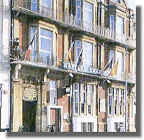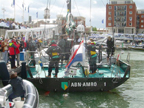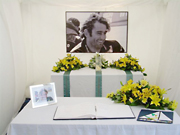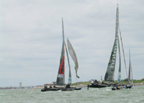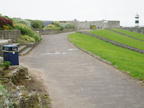|
|||||||||||||||||
No Worries, Mate
I crossed the pond to Portsmouth to see my friends from Brasil1 and to write a story about a drowned sailor and a lost sailboat. But that was never the real story. story and photos by Steve CarrPortsmouth, England—It took the Volvo Ocean racers about 10 days to cross the North Atlantic from New York to Portsmouth, England. During that treacherous voyage, a Dutch lad named Hans Horrevoets was lost overboard; shortly after, the Spanish boat Movistar was abandoned when its keel malfunctioned and took on water.
I had become quite friendly with the team from Brasil during their stopover in Baltimore and Annapolis, so I decided to fly across the big pond for a surprise visit. I had several goals in mind. First, I wanted to find out the real story — the story behind the headlines — on the loss of life and ship during Leg 7. I also wanted to see how the Brits did Volvo. Last but not least, I wanted to party samba-style with my Brazilian friends in a foreign city by the sea. Finding PortsmouthI flew all night and landed at Gatwick Airport mid-morning, having grabbed little sleep. An hour later, I was motoring down the M23 in my rental car, driving on the left-hand side of the road and taking in the lush English countryside. This was what the Brits refer to as a bank holiday weekend, and just like in Maryland, everyone was trying to reach the beach. As I neared the seaside towns of Brighton, Arundel and Chichester, I queued up in the endless lines of beachgoers, navigating roundabouts and traffic lights. It felt just like coming into the bottleneck towns of Easton and Cambridge on my way to Ocean City. Arriving in Portsmouth at noon, I followed the signs to Gunwharf Quay, a revitalized complex of trendy shops and restaurants overlooking Portsmouth Harbor, where the six Volvo boats were to be moored. Framing the anchorage is one of Europe’s tallest free-standing structures, the Spinnaker Tower. Rising 557 feet above England’s second busiest harbor, the glistening white concrete tower looks like a spinnaker blowing in the breeze. I could see the flag-bedecked masts of the Volvo racers straight ahead as I emerged from the underground parking lot. I was so excited, I almost started running. But only three of the Volvos were there, and Brasil wasn’t one of them. Lucas Brun, a Brazilian crewing on ABN AMRO 2, the boat where Hans had been lost, directed me to the historic Portsmouth Naval Yard a couple blocks away, where some of the boats were still being serviced after their brutal Atlantic crossing. Portsmouth has been Britain’s principal naval facility since the 15th century, and at any given time, there will be at least 10 Sheffield Class destroyers, aircraft carriers and other vessels of war being refitted for duty. Large gray cranes dot the skyline like prehistoric birds. This was no free-wheeling Baltimore. Security was tight, with machine-gun toting soldiers all over the place, especially inside the gates of the Naval Base. At the first secure entrance, I discovered my pass only worked on the Chesapeake, and I was dead in the water. But as my Brasil buds often say, No worries, mate. At the media center, I talked my way into a dock pass and was off to the races. History was deeper, too. Along the way I encountered a myriad of old sailing ships: HMS Warrior, Britain’s first ironclad, built in 1860; the four-master Mary Rose, which was built in 1509 and sank within eyesight of Henry the VIII’s army along Southsea Common while engaging the French in battle; HMS Victory, the three-masted flagship of Admiral Horatio Nelson when he defeated the combined French and Spanish fleets off Trafalgar, Spain in 1805. Reunited
Busily preparing the boat for sail near the rear of the Naval Yard, the Brasil shore crew embraced me like their long-lost golden retriever. I was dressed in team colors and was informed that we had to have the boat safely moored in her Gunwharf Quay anchorage by four that afternoon. First I needed a hotel room and a place to park my rental car. As I walked back into town I ran into Ricardo, Brasil’s diver, and he gave me another dock pass in case the one I had didn’t work. My next stop was the Keppel’s Head Hotel right outside Gunwharf Quay. The manager explained that every accommodation in town was probably full because of the Volvo race. I pointed to my blue shirt and told him I was with Team Brasil. He flashed a big smile and said he had been reading about the race all week. “I would just love to see those ships,” he said. I pulled out my spare dock pass and handed it to him with a wink. “No worries, mate.” The next thing I knew I was parking my car in the hotel lot and carrying my bag up to a spacious room overlooking the ferryboat launch to the Isle of Wight, which sits a few miles across The Solent from Portsmouth. Back at Brasil, by four o’clock we had the boat ready to rock. We motored to our dock space at the now-bustling Gunwharf Quay as a Dutch tall ship from Amsterdam was arriving. All six Volvo boats were now together again. It was Friday. Happy hour beckoned. So we headed over to a two-story glass and stainless steel bar called TIGER TIGER. This was the official hangout for all the racing teams, a phenomenon I hadn’t encountered during the B&A stop, where each crew had its own team bar. But the AMRO syndicate, whose motto is Making More Possible, had been the recipient of a huge infusion of corporate cash after the death of Hans. AMRO shared the wealth by running an open bar tab for anyone affiliated with any of the racing teams.
“They just went over the 100,000 pound mark ($160,000),” the manager told me. “And the weekend’s still early.” Waking up in a time-warped fog the next morning, I stumbled into the Keppel’s Head’s Victorian dining room for a hearty English breakfast before returning to the Gunwharf dock, where I spent the only sunny day of my trip working on Brasil. That afternoon, we took her for a practice sail to see if our repairs had been successful. I will forever cherish my sail on Brasil, listening to the groans of the stays as we went to weather, feeling the incredible acceleration when a wind gust knocked us over, sailing with the happy crew in their spectacular blue and yellow racing machine. I felt like I was riding atop a living, breathing animal: a modern sea dragon. Race 1My next mission was to find Emma, who runs the Volvo Extreme 40 races. Volvo Extreme 40s are carbon-fiber, 40-foot catamarans that consistently sail at 25 knots or better. At the Vigo, Capetown, Rio and Baltimore stops, the 40s staged five days of racing, with an overall winner to be crowned at the final series next wee
k in Rotterdam. I found Emma tucked away in a trailer inside one of the shipyard’s cavernous warehouses. After offering my services, I was soon speeding out of Portsmouth Harbor with an around-the-world sailor from England named Tasmin, in a 20-foot inflatable rib sporting a 200-horsepower Volvo Penta inboard engine. Our job was to set the marks for the races. I had done this in Baltimore, but out in the three-foot chop and 20-knot winds of The Solent — the channel between the Isle of Wight and the mainland — mark-setting was a whole new ballgame. We had little trouble setting the windward mark near Southsea Castle, where thousands of British families on holiday lined the Millennium Walk along the shoreline. But things got a bit dicey when we started to set the leeward mark off the long pier in front of a large white amusement park that reminded me of Atlantic City. I had set the anchor and was savagely (and profanely) trying to unravel the line that had turned into a ball of snakes when I heard the unmistakable sound of an approaching Volvo 40. I looked back over my shoulder, and there was Basilica bearing down on us at about 20 knots and up on one pontoon. “Keep the boat behind the buoy ’cause we are now the mark,” I said to Tasmin. I held firmly to the buoy so it didn’t drift any farther as the other four racing cats screamed by, not in the least bit fazed by the goofy guy from Maryland who obviously had the good sense not to keep playing out the line and turn the leeward mark into a moving target. A Short Memorial
Monday, May 29 broke ugly, wet and cold. At 11am, the fleet got a much-needed blessing. An English minister in flowing white robes stood high above Gunwharf Quay, surrounded by hundreds of spectators and crews, reading a brief homily for Hans Horrevoets. Other than the small tent erected above the docks for people to reflect and perhaps sign a book of condolences, this was the only allusion to the accident that claimed the life of the 32-year-old Dutch sail maker and father of two. The chaplain read the poem “Down to the Sea in Ships,” then asked for a moment of silence. There wasn’t a dry eye to be seen. Crew on every boat broke down. It was the saddest minute of my life, yet, in many ways, the luckiest. Race 2I was going to be spending the whole day strapped into a 20-foot rib with no seats as we followed around the 24-mile in-port race course in eight-foot seas with a 30-knot breeze sharp with off-and-on pelting needle rain. The Volvos sliced through the nasty chop and wind with a grace that made the ocean seem almost tame. On the rib, going incredibly fast as we shadowed Brasil for over four hours, I was constantly in fear for my life. I never felt safe, not for a second.
Since the start of the Volvo Ocean Race, we have heard about how the big-butt design of AMRO 1 makes it faster than the other boats in heavy weather. But on the Chesapeake, the winds never got strong enough to let Black Betty strut her stuff. Out on The Solent, she was in her element, and that boat muscled her way past the rest of the fleet, easily finishing first, with Pirates a distant second, then Brasil a close third. A Long WeddingAfter the race, we took the Brasil rib across the harbor to Endeavor Quay, a marina rented by the ABN AMRO syndicate for a gala blowout in honor of the Saturday wedding between Mike Sanderson (aka Moose), the skipper of the winning AMRO 1, and Emma Riley, an around-the-world sailor from Portsmouth. The entire collective spirit and energy of the Volvo family had slowly been building all week for the in-port race and wedding bash. Everyone was embracing the light of hope as they put to rest their fallen companion. With wild abandon, the liquor flowed and the music played inside the main tent.
There was a mechanical moose to ride and fancy food galore. The entertainment featured the Volvo Ocean Race Band, comprised of sailors and shore crew from the teams, and they were a total hoot. The Legends of Rock, featured lounge singers impersonating Neil Diamond, Elvis and Marilyn Manson. Mike and Emma danced almost every song, and the party went until the wee hours of the morning. A Long GoodbyeI came over to Portsmouth to see my friends from Brasil and to write a story about a drowned sailor and a lost sailboat. But that was never the real story. Here’s the real story. And I didn’t need to go to Portsmouth to find it. A friend’s mother died of cancer many years ago. Each year, my friend does the Relay for Life, where she and her teammates walk around a track all night to raise money for cancer research. At midnight, they light candles in paper bags with the name of their loved one attached. My friend always dedicates her luminaria in memory of her mom. This year she did one for Hans Horrevoets. She never met him, and she doesn’t even sail. But his spirit touched her heart. And that, my friends, is what the Volvo Ocean Race is really all about.
|
|||||||||||||||||
|
|
|||||||||||||||||
|
© COPYRIGHT 2004 by New Bay Enterprises, Inc. All rights reserved.
|



